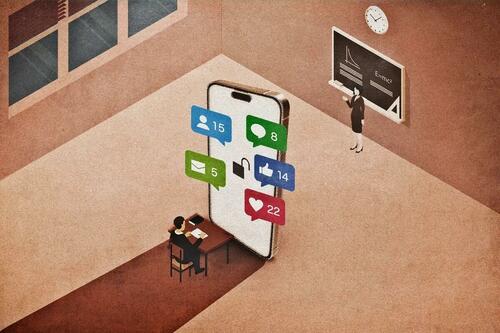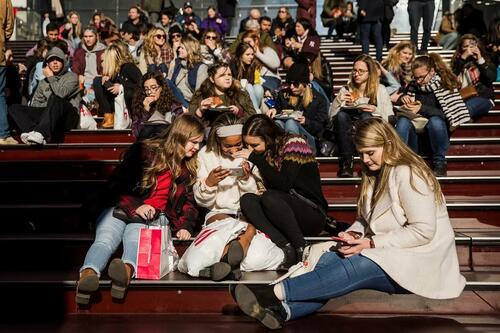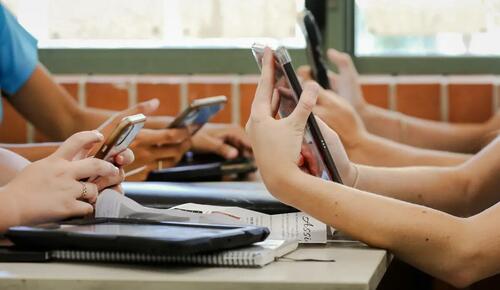Authored by Ross Muscato via The Epoch Times (emphasis ours),
After decades in the classroom, award-winning teacher Steve Gardiner, of Billings, Montana, became acutely aware of a new problem making it difficult for his high-school students to learn.

Ironically, it was the so-called smartphone.
“The phones were disruptive and distracting—the most disruptive and distracting thing in the classroom in my 38 years of teaching,” Mr. Gardiner, now retired, told The Epoch Times.
“Students could not stop looking at them. And when they weren’t looking at them, they were thinking about looking at them. I called it an addiction."
Experts now are calling attention to how smartphone use in the classroom can have negative effects on learning and safety at school. They show evidence that suggests allowing students to keep the devices with them during the school day leads to poorer academic performance, and sometimes even compromised safety and an increased chance of devastating consequences of bullying.
Mr. Gardiner takes teaching—and impediments to it—seriously. He holds a doctorate in education, served three years on the board of directors of the National Board for Professional Teaching Standards. He was Montana's Teacher of the Year in 2008.
While teaching English at Billings Senior High School, he was so concerned about the impact of phones on learning that he conducted an informal survey. He asked eight business owners in town how they addressed employee use of cellphones on the job.
"It was amazing," Mr. Gardiner said. "All but one had a variation of the same policy, and that was that texting on the job was not allowed, and an employee would be given two warnings, if caught texting, and after that, he would be terminated.”
The only exception was the local newspaper, he said, because staff sending texts "to ask questions, research, and receive information was part of the job.”
Teens Tethered to Phones
As the government response to the COVID-19 pandemic caused social isolation and prolonged absences from school, children's time online increased dramatically.
In the United States, children and teens aged 10 to 14 more than doubled their daily time online, going from an average of 3.8 hours to 7.7 hours, according to research published in a JAMA Pediatrics research letter on Nov. 1, 2021.

Even as quarantine restrictions were reversed, the authors wrote, "screen use remains persistently elevated.”
Almost all students have smartphones now.
“Getting a smartphone is now a rite of passage for most children and adolescents in the United States,” states Common Sense Media in its 2023 study titled “Constant Companion: A Week in the Life of a Young Person’s Smartphone Use.”
The study notes that "about half of U.S. children get their smartphone by age 11."
Common Sense Media—citing its own data and research from Peggy Rideout and the Pew Research Center—reported that 88 percent to 95 percent of teens (aged 13 to 18) have their own smartphone.
Shortly after Apple introduced the iPhone in 2007, almost all schools implemented some sort of ban on phones.
But the breadth of the ban has fluctuated over the years.
In 2009, 90 percent of U.S. schools had bans on cell phones in class, according to the National Education Association (NEA).
By 2015, only 67 percent of schools had cell phone bans.
In 2020, the number of schools banning smartphones had jumped back up to 77 percent of schools, according to the National Center for Education Statistics.
Teachers have been competing with cell phones for the eyes and ears of students for more than a decade, an insight documented by a 2010 Pew Research Center study. It includes data from 2009, when 90 percent of U.S. schools had cellphone bans.
Of the teens surveyed, 62 percent said they could have their phones in school but not in class, and 24 percent were not allowed to have phones on school property. Of those who attended a school with a total ban, 65 percent brought their phones to school anyway, and 58 percent texted in class.
While in class, 64 percent of teens said they had texted, and 25 percent had made or received a call, researchers found.

Growing Opposition to Phones in School
Arnold Glass understands well the lure and attraction of the phone to students.
Mr. Glass, a professor of cognitive psychology at Rutgers University, led a team that, in 2018, published the first academic study documenting how cell phones in classrooms lower student test scores.
"The negative effects of cell phones in the classroom were immediately obvious, which led to the initial bans," Mr. Glass told The Epoch Times.
"However, there was pushback from parents and school boards, and principals caved in to what they knew was a destructive policy" and allowed students to bring them to school.
"Now school boards are being sued by parents for outcomes—including bullying—that are consequences of permitting cell phones in schools," he said. "So, the self-protective bans are being reinstated."
While bans in varying forms are common now throughout the nation, only Florida has made it the law. In May, two weeks before announcing his presidential run, Gov. Ron DeSantis signed House Bill 379, which prohibits student use of phones in class during instructional time in public schools.

And in Florida, the school board of Orange County Public Schools (OCPS)—the eighth largest public school district in the country—instituted an even more restrictive cell phone policy than the state law.
Under the new regulations, approved in August, students are prohibited, except in an emergency, from using their phones at any time during the school day. Students are allowed to have their phones on them, as long as they're kept in a backpack.
OCPS now is conducting a survey asking students, parents, and teachers about the policy and how it can be improved. The survey results will be released after winter break.
Yet already there is positive feedback on the phone restrictions, OCPS media relations manager Michael Ollendorff told The Epoch Times.
“Anecdotally, we are seeing an improvement in grades, and more positive in-person interactions among students," Mr. Ollendorff said.
"We are also finding that during lunchtime—when in the past kids were busy on their phones—they're now playing games, including pickleball and cornhole."
Lawmakers in Congress also are considering the topic of cellphones in school.
In October, U.S. Sens. Tom Cotton (R-Ark.) and Tim Kaine (D-Va.) introduced the Focus on Learning Act. The bill would appropriate $5 million for the Secretary of Education to “conduct a study regarding the use of mobile devices in elementary schools, and to establish a pilot program of awarding grants to enable certain schools to create a school environment free of mobile devices."
China, the United Kingdom, France, the Netherlands, and other nations have established variations of bans on phones in class.
In August, the United Nations Educational, Scientific and Cultural Organization (UNESCO) called for an international ban on smartphones in classrooms. The United States is a member of UNESCO.
Proof of the Problem
"Dividing attention in the classroom reduces exam performance," Mr. Glass showed in a 2017 study published in the academic journal Educational Psychology. He co-authored the work with Mengxue Kang, a fellow professor of cognitive psychology at Rutgers.
The study is often referenced by those advocating for bans or curtailed access to phones in school.
“I've studied learning and memory for over 50 years,” Mr. Glass said. One of his main pursuits has been "to create instruction tools to improve performance in the classroom."
Research and analysis of the academic performance of his students from 2005 through 2010 showed that the technology and tools he implemented in his teaching and in the classroom environment were producing positive results, he said.

“The students were doing better in their exams every year until 2010, when we hit a ceiling, and then marks started falling, and I needed to see why,” Mr. Glass said.
Read the rest here...